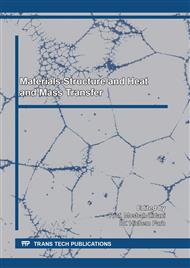[1]
A. Kumar, S. Ranjan, O. Prakash, and A. Shukla, Exergy Analysis of Solar Dryers,, in Solar Drying Technology: Springer, 2017, pp.239-262.
DOI: 10.1007/978-981-10-3833-4_8
Google Scholar
[2]
S. Deshi, D. Wonang, and B. Dafur, Control of rots and spoilage of agricultural products: a review,, Academic Journal of Interdisciplinary Studies, vol. 3, no. 7, pp.38-38, (2014).
DOI: 10.5901/ajis.2014.v3n7p38
Google Scholar
[3]
S. Vijayan, T. Arjunan, and A. Kumar, Fundamental concepts of drying,, in Solar Drying Technology: Springer, 2017, pp.3-38.
DOI: 10.1007/978-981-10-3833-4_1
Google Scholar
[4]
J. Banout, Solar Drying Systems,, (in English), (2017).
Google Scholar
[5]
G. Pirasteh, R. Saidur, S. Rahman, and N. Rahim, A review on development of solar drying applications,, Renewable and Sustainable Energy Reviews, vol. 31, pp.133-148, (2014).
DOI: 10.1016/j.rser.2013.11.052
Google Scholar
[6]
L. Bennamoun, Reviewing the experience of solar drying in Algeria with presentation of the different design aspects of solar dryers,, Renewable and Sustainable Energy Reviews, vol. 15, no. 7, pp.3371-3379, (2011).
DOI: 10.1016/j.rser.2011.04.027
Google Scholar
[7]
G. Yuan, L. Hong, X. Li, L. Xu, W. Tang, and Z. Wang, Experimental investigation of a solar dryer system for drying carpet,, Energy procedia, vol. 70, pp.626-633, (2015).
DOI: 10.1016/j.egypro.2015.02.170
Google Scholar
[8]
M. Ndukwu, D. Onyenwigwe, F. Abam, A. Eke, and C. Dirioha, Development of a low-cost wind-powered active solar dryer integrated with glycerol as thermal storage,, Renewable Energy, (2020).
DOI: 10.1016/j.renene.2020.03.016
Google Scholar
[9]
S. Murali, P. Amulya, P. Alfiya, D. A. Delfiya, and M. P. Samuel, Design and performance evaluation of solar-LPG hybrid dryer for drying of shrimps,, Renewable Energy, vol. 147, pp.2417-2428, (2020).
DOI: 10.1016/j.renene.2019.10.002
Google Scholar
[10]
H. Atalay, Comparative assessment of solar and heat pump dryers with regards to exergy and exergoeconomic performance,, Energy, vol. 189, p.116180, (2019).
DOI: 10.1016/j.energy.2019.116180
Google Scholar
[11]
A. Khanlari, A. Sözen, C. Şirin, A. D. Tuncer, and A. Gungor, Performance enhancement of a greenhouse dryer: Analysis of a cost-effective alternative solar air heater,, Journal of Cleaner Production, vol. 251, p.119672, (2020).
DOI: 10.1016/j.jclepro.2019.119672
Google Scholar
[12]
S. Soodmand-Moghaddam, M. Sharifi, and H. Zareiforoush, Investigation of fuel consumption and essential oil content in drying process of lemon verbena leaves using a continuous flow dryer equipped with a solar pre-heating system,, Journal of cleaner production, vol. 233, pp.1133-1145, (2019).
DOI: 10.1016/j.jclepro.2019.06.083
Google Scholar
[13]
M. Cherier, T. Benouaz, S. Bekkouche, and M. Hamdani, Some solar passive concepts in habitat through natural ventilation case study: Dry climate in Algeria Ghardaia,, Case studies in thermal engineering, vol. 12, pp.1-7, (2018).
DOI: 10.1016/j.csite.2018.02.002
Google Scholar
[14]
A. Benseddik, A. Azzi, F. Chellali, and R. Khanniche, An analysis of meteorological parameters influencing solar drying systems in Algeria using the isopleth chart technique,, Renewable Energy, vol. 122, pp.173-183, (2018).
DOI: 10.1016/j.renene.2018.01.111
Google Scholar
[15]
A. Labed, N. Moummi, K. Aoues, and A. Benchabane, Solar drying of henna (Lawsonia inermis) using different models of solar flat plate collectors: an experimental investigation in the region of Biskra (Algeria),, Journal of Cleaner Production, vol. 112, pp.2545-2552, (2016).
DOI: 10.1016/j.jclepro.2015.10.058
Google Scholar
[16]
S. Boughali, H. Benmoussa, B. Bouchekima, D. Mennouche, H. Bouguettaia, and D. Bechki, Crop drying by indirect active hybrid solar–Electrical dryer in the eastern Algerian Septentrional Sahara,, Solar energy, vol. 83, no. 12, pp.2223-2232, (2009).
DOI: 10.1016/j.solener.2009.09.006
Google Scholar
[17]
P. Hempattarasuwan, P. Somsong, K. Duangmal, M. Jaskulski, J. Adamiec, and G. Srzednicki, Performance evaluation of parabolic greenhouse-type solar dryer used for drying of cayenne pepper,, Drying Technology, vol. 38, no. 1-2, pp.48-54, 2020/01/02 2020,.
DOI: 10.1080/07373937.2019.1609495
Google Scholar
[18]
M. Goud, M. V. V. Reddy, V. Chandramohan, and S. Suresh, A novel indirect solar dryer with inlet fans powered by solar PV panels: Drying kinetics of Capsicum Annum and Abelmoschus esculentus with dryer performance,, Solar Energy, vol. 194, pp.871-885, (2019).
DOI: 10.1016/j.solener.2019.11.031
Google Scholar


